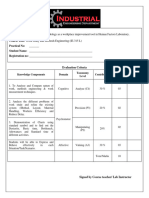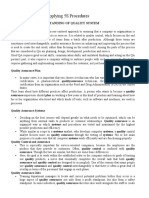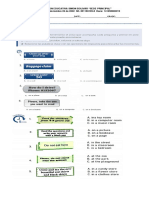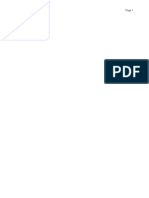0 ratings0% found this document useful (0 votes)
13 viewsKeywords 5s
Keywords 5s
Uploaded by
Novita PutraThe document discusses the 5S methodology which includes sorting, setting in order, shining, standardizing, and sustaining. The sorting step aims to remove unnecessary items. Setting in order creates good visual management by organizing what items go where. Shining promotes safety through cleaning. Standardizing establishes workplace norms. Sustaining requires communication, education, rewards, and regular audits.
Copyright:
© All Rights Reserved
Available Formats
Download as DOCX, PDF, TXT or read online from Scribd
Keywords 5s
Keywords 5s
Uploaded by
Novita Putra0 ratings0% found this document useful (0 votes)
13 views1 pageThe document discusses the 5S methodology which includes sorting, setting in order, shining, standardizing, and sustaining. The sorting step aims to remove unnecessary items. Setting in order creates good visual management by organizing what items go where. Shining promotes safety through cleaning. Standardizing establishes workplace norms. Sustaining requires communication, education, rewards, and regular audits.
Original Title
keywords 5s
Copyright
© © All Rights Reserved
Available Formats
DOCX, PDF, TXT or read online from Scribd
Share this document
Did you find this document useful?
Is this content inappropriate?
The document discusses the 5S methodology which includes sorting, setting in order, shining, standardizing, and sustaining. The sorting step aims to remove unnecessary items. Setting in order creates good visual management by organizing what items go where. Shining promotes safety through cleaning. Standardizing establishes workplace norms. Sustaining requires communication, education, rewards, and regular audits.
Copyright:
© All Rights Reserved
Available Formats
Download as DOCX, PDF, TXT or read online from Scribd
Download as docx, pdf, or txt
0 ratings0% found this document useful (0 votes)
13 views1 pageKeywords 5s
Keywords 5s
Uploaded by
Novita PutraThe document discusses the 5S methodology which includes sorting, setting in order, shining, standardizing, and sustaining. The sorting step aims to remove unnecessary items. Setting in order creates good visual management by organizing what items go where. Shining promotes safety through cleaning. Standardizing establishes workplace norms. Sustaining requires communication, education, rewards, and regular audits.
Copyright:
© All Rights Reserved
Available Formats
Download as DOCX, PDF, TXT or read online from Scribd
Download as docx, pdf, or txt
You are on page 1of 1
The first step in 5S “Sort” aims to figure out The goal of “Set in Order” is to create good visual
which materials or items need to be management. Consider these three important
removed by sorting. points: (1) what items to position, (2) the quantity,
Gather your team and ask if there are and (3) where to place items accordingly.
defective tools and equipment, outdated Always allocate and store items in accessible and
items, and other non-essential materials on navigable spots.
site. Group tools and items based on use and function
Determine how frequent you use workplace and label or color-code them so they are easier to
items or tools (daily, weekly, monthly, or find and identify.
never) and apply the red tagging technique
Heavy loads and materials should be placed at an
when unsure in the removal of items. Red
appropriate height where the worker can easily
tagged materials must undergo verification
before taking necessary action. pick or carry them without straining.
Temporarily store items that are difficult to
classify.
Housekeeping and cleaning are essential Establish a culture of discipline.
ways to not only remove dust, dirt, and When the first three S’s are established, best
other waste, but also to promote safety in practices should be standardized by means of
the workplace. Activities and items that creating the workplace norm or company
cause dirt, contamination, and filth are culture that every worker must conform with.
traced and actioned. With proper
application of the Shine principle, work
processes can be improved or corrected.
**our things are like words. Organization is Communication - Have all new procedures
like grammar that creates meaning. been rolled out to all workers? Are workers
**the objective of cleaning is not to clean, aware of their responsibility to report
but to feel happiness living within that ineffective processes?
environment. Education - Are adequate trainings
conducted for workers?
Rewards and recognition - Are all workers’
effort recognized through rewards?
Time - How often do you audit
housekeeping practices? Scheduled daily,
weekly, or monthly? Do you allot enough
time to check if new processes are indeed
effective?
You might also like
- Design Work Standards and Manpower PlanningDocument46 pagesDesign Work Standards and Manpower PlanningRechelle100% (1)
- 5R Audit FormDocument6 pages5R Audit FormAriefFerdianNo ratings yet
- Cat 315 GiroDocument4 pagesCat 315 GiroFranciscoOliveira100% (1)
- Moving Average GuideDocument16 pagesMoving Average Guidesuisuifx538795% (66)
- Apply 5s ProceduresDocument27 pagesApply 5s ProceduresAdoniyas MadeboNo ratings yet
- 5SDocument2 pages5SROSE OPEL ASPILLANo ratings yet
- WorkspaceDocument1 pageWorkspacesadiaNo ratings yet
- Redu the 5S MethodologyDocument6 pagesRedu the 5S Methodologydaninazu512No ratings yet
- Lean Chapter 6Document46 pagesLean Chapter 6WinterMist11No ratings yet
- 5s ReportDocument15 pages5s ReportAkash KarbotkarNo ratings yet
- UntitledDocument11 pagesUntitledkamranp1No ratings yet
- Maintain Measuring InstrumentsDocument4 pagesMaintain Measuring InstrumentsJohn Philip MalonesNo ratings yet
- Good HousekeepingDocument15 pagesGood Housekeepingsotolombo.ckNo ratings yet
- Maintenance Methods and SystemsDocument6 pagesMaintenance Methods and Systemsrocelin padonNo ratings yet
- (Seiri) : Hiroyuki Hirano in His Book "5 Pillars of The Visual Workplace", All Starting With Letter S' Which MeansDocument7 pages(Seiri) : Hiroyuki Hirano in His Book "5 Pillars of The Visual Workplace", All Starting With Letter S' Which MeansNarottamShandilyaNo ratings yet
- MTP PDFDocument7 pagesMTP PDFNarottamShandilyaNo ratings yet
- MTP PDFDocument7 pagesMTP PDFNarottamShandilyaNo ratings yet
- 5 S Japanese Concept (Implementation)Document5 pages5 S Japanese Concept (Implementation)KushNo ratings yet
- Module-Iv Quality Circles: 1) Process BenchmarkingDocument8 pagesModule-Iv Quality Circles: 1) Process BenchmarkingPrashant JhaNo ratings yet
- Lab Module6 - WSME - 6SDocument5 pagesLab Module6 - WSME - 6SHamza ShahzadNo ratings yet
- Assignment On Achieving Quality With 5 S AQM M.F.Tech - II SemDocument26 pagesAssignment On Achieving Quality With 5 S AQM M.F.Tech - II SempetcutpaulNo ratings yet
- Apply 5S Procedure and OHHDocument12 pagesApply 5S Procedure and OHHasmasheawwalNo ratings yet
- Programa Orden y Aseo House KeepingDocument7 pagesPrograma Orden y Aseo House KeepingninivelangelNo ratings yet
- lesson-1-7S-in-the-workplaceDocument28 pageslesson-1-7S-in-the-workplacecedrogerlie1No ratings yet
- 5S Is A Defined Visual Simple Method For Maintaining The Workplace in The Optimum Condition and Eliminate WasteDocument1 page5S Is A Defined Visual Simple Method For Maintaining The Workplace in The Optimum Condition and Eliminate Wastejplarazi100% (1)
- Apply 5S ProcedureDocument14 pagesApply 5S ProcedurehailuNo ratings yet
- Apply 5S ProcedureDocument9 pagesApply 5S Procedureerkoo bekeleNo ratings yet
- Online Library of Quality, Service Improvement and Redesign ToolsDocument5 pagesOnline Library of Quality, Service Improvement and Redesign ToolsAntonio TiradoNo ratings yet
- 5s QCM NTDocument3 pages5s QCM NTnoyon debNo ratings yet
- 5 SDocument3 pages5 SEvelyn Anette De la Cruz VargasNo ratings yet
- Analysis and Application of 5smethodology in Mechanical Work Shop of Rungta College of Engineering and Technology, RaipurDocument6 pagesAnalysis and Application of 5smethodology in Mechanical Work Shop of Rungta College of Engineering and Technology, RaipurDebaprava DasNo ratings yet
- 03 GSS 5S IntroductionDocument21 pages03 GSS 5S IntroductionRavikumar BojjaNo ratings yet
- 5S - Good HousekeepingDocument39 pages5S - Good Housekeepingrslapena100% (10)
- Hos KipingDocument12 pagesHos KipingBaskoro Ardy KusumaNo ratings yet
- Lean Manufacturing - 5 S Principles Lean InitiativesDocument3 pagesLean Manufacturing - 5 S Principles Lean InitiativesAnonymous v5QjDW2eHxNo ratings yet
- Bulletin EQM 89 - 5SDocument40 pagesBulletin EQM 89 - 5SApurv BhattacharyaNo ratings yet
- Manual 5SDocument5 pagesManual 5Shernandezsst76No ratings yet
- Designing Work Standards and Manpower PlanningDocument58 pagesDesigning Work Standards and Manpower PlanningShiena AcedoNo ratings yet
- 5s As A Tool and Strategy For Improvising The Work PlaceDocument3 pages5s As A Tool and Strategy For Improvising The Work PlaceOscar PedrozaNo ratings yet
- 5s LearningDocument35 pages5s LearningAnkur100% (1)
- Revised Tle As CSS 10 Q3 WK8Document4 pagesRevised Tle As CSS 10 Q3 WK8Jonald SalinasNo ratings yet
- Implementing 5S MethodologyDocument4 pagesImplementing 5S MethodologyMuhammad Ramzan MalickNo ratings yet
- Computer Maintenance PlanningDocument21 pagesComputer Maintenance PlanningClark DomingoNo ratings yet
- Q4 TLE AFA Horticulture 9 Week5Document4 pagesQ4 TLE AFA Horticulture 9 Week5Dash BelloNo ratings yet
- 5S-Lean Audit Checklist - ManufacturingDocument4 pages5S-Lean Audit Checklist - ManufacturingkajalNo ratings yet
- The 5S MethodDocument2 pagesThe 5S Methodbellaritaje5No ratings yet
- 5s in Simba Apparels KenyaDocument19 pages5s in Simba Apparels KenyaPrerna Khatri100% (1)
- 5s Japanese MethodDocument24 pages5s Japanese MethodPraful E. PawarNo ratings yet
- Impact of Decluttering Your Workspace On Mental Well-BeingDocument20 pagesImpact of Decluttering Your Workspace On Mental Well-BeingFrancisca CastroNo ratings yet
- 5s ImplementationDocument20 pages5s ImplementationHerry Prakoso100% (1)
- Visual Management: Visual Management Is A Set of Techniques ThatDocument28 pagesVisual Management: Visual Management Is A Set of Techniques ThatBangaru BharathNo ratings yet
- Total Quality Management Group 3Document9 pagesTotal Quality Management Group 3JovertNo ratings yet
- Shingo Operational ExcellenceDocument23 pagesShingo Operational ExcellencekapileshwariNo ratings yet
- U1 - Act - 01 - Programa 9S-1Document9 pagesU1 - Act - 01 - Programa 9S-1Yahir CuteñoNo ratings yet
- DIKW - Lean ManufacturingDocument3 pagesDIKW - Lean ManufacturingShweta JoshiNo ratings yet
- U1 Act 01 Programa 9sDocument3 pagesU1 Act 01 Programa 9sYahir CuteñoNo ratings yet
- Group Number 1: Renu Kapoor Peu Banerjee Swati Ritu Vishwakarma Ashwin HazariDocument36 pagesGroup Number 1: Renu Kapoor Peu Banerjee Swati Ritu Vishwakarma Ashwin HazariPeu BanerjeeNo ratings yet
- 5S TBT - February 2024 Week 3Document1 page5S TBT - February 2024 Week 3maxwell odhiamboNo ratings yet
- Assignment TQM 4Document5 pagesAssignment TQM 4Aiswarya ASNo ratings yet
- 5S- The True Mean to Enhance Productivity and Work Value for Customers: Toyota Production System ConceptsFrom Everand5S- The True Mean to Enhance Productivity and Work Value for Customers: Toyota Production System ConceptsRating: 5 out of 5 stars5/5 (1)
- Becoming Lean: Practical Steps to Build CompetitivenessFrom EverandBecoming Lean: Practical Steps to Build CompetitivenessRating: 5 out of 5 stars5/5 (1)
- Workbook & Summary - Getting Things Done - Based On The Book By David AllenFrom EverandWorkbook & Summary - Getting Things Done - Based On The Book By David AllenNo ratings yet
- Unit I: National Income and Related AggregatesDocument31 pagesUnit I: National Income and Related AggregatesB. ABINESHNo ratings yet
- Instruction Manual - Firma-WebDocument45 pagesInstruction Manual - Firma-WebrfaNo ratings yet
- Substation Protection TrainingDocument13 pagesSubstation Protection TrainingOrissa KonsbahalNo ratings yet
- Solution Test April 2019Document4 pagesSolution Test April 2019AMIRAH MAISARAH AHMAD KAMALNo ratings yet
- Delimitation Commission KarnatakaDocument70 pagesDelimitation Commission KarnatakaDEEPAKNo ratings yet
- Australia's Water Efficiency Labelling and StandardsDocument12 pagesAustralia's Water Efficiency Labelling and StandardsSergio Blanco LondoñoNo ratings yet
- PREPARACIÓN PREGUNTAS SABER 11 INGLES PARTE 1-2-3-4 Modificado PDFDocument13 pagesPREPARACIÓN PREGUNTAS SABER 11 INGLES PARTE 1-2-3-4 Modificado PDFGandy RodriguezNo ratings yet
- 2019 International OER GuideDocument11 pages2019 International OER Guideforplaystore087No ratings yet
- Bank Bumiputra (M) BHD V Hashbudin Bin HashiDocument10 pagesBank Bumiputra (M) BHD V Hashbudin Bin HashiNorlia Md DesaNo ratings yet
- Transverse Shear Stress 2024Document16 pagesTransverse Shear Stress 2024Anno NimNo ratings yet
- Agni 21 9 3 FTDocument1 pageAgni 21 9 3 FTdhanarajNo ratings yet
- Chapter 14 Principle of Neutralization TDocument29 pagesChapter 14 Principle of Neutralization TS. MartinezNo ratings yet
- When To Eat FlaxseedDocument3 pagesWhen To Eat FlaxseedAarya ShekhawatNo ratings yet
- Business Environment - MergedDocument142 pagesBusiness Environment - MergedAkhilesh JadhavNo ratings yet
- Diwali Mela Concept NoteDocument4 pagesDiwali Mela Concept NotebiggbossNo ratings yet
- Lord Make Us ReadyDocument1 pageLord Make Us Readytim NjumeNo ratings yet
- Help For 22 Years From InternetDocument130 pagesHelp For 22 Years From InternetChiamaka AngelaNo ratings yet
- About TESCO EquipmentsDocument24 pagesAbout TESCO EquipmentsfilbryantNo ratings yet
- Kausel - Stiffness MatrixDocument19 pagesKausel - Stiffness MatrixkozloNo ratings yet
- Laird Barron - Hour of The CyclopsDocument9 pagesLaird Barron - Hour of The CyclopsJuvanji JuvanjiNo ratings yet
- No Bake PanforteDocument2 pagesNo Bake PanforteLwica Oczy NiebaNo ratings yet
- Configuration TO Asset Accounting (Fi) : WelcomeDocument36 pagesConfiguration TO Asset Accounting (Fi) : Welcomevishal_160184No ratings yet
- Project On Commercialisation of SportsDocument91 pagesProject On Commercialisation of Sportsraysubha12367% (3)
- 2017.0050 - TRS - BAO MINH - r.00 02-18 - ENDocument52 pages2017.0050 - TRS - BAO MINH - r.00 02-18 - ENNguyễn Huy CườngNo ratings yet
- Essentials of Nuclear Chemistry by HJ ArnikarDocument6 pagesEssentials of Nuclear Chemistry by HJ Arnikarlalatendu.nayak70% (1)
- CSR Indian OilDocument9 pagesCSR Indian OilDeepak NayakNo ratings yet
- Step by Step Oracle Installation Guides Kamran AgayevDocument201 pagesStep by Step Oracle Installation Guides Kamran AgayevSayed NabilNo ratings yet
- Research Subject Informed Consent Form: Raphael LDocument3 pagesResearch Subject Informed Consent Form: Raphael LKyla Grace GuerzoNo ratings yet

























































































